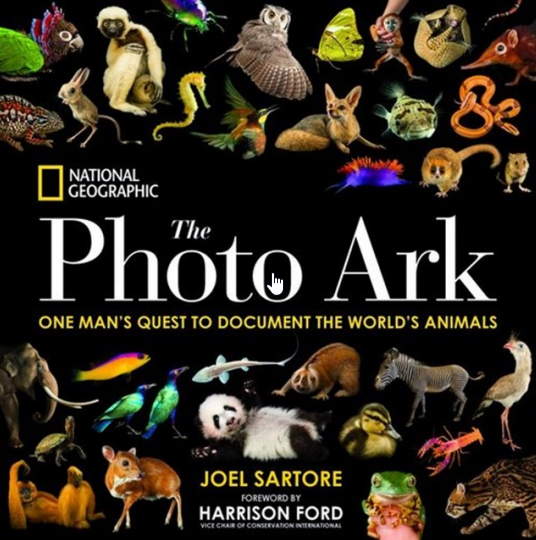Photography, The Photo Ark and Great Visual Storytelling
By: Gary Conkling
Joel Satore has dedicated his life to capturing intimate, face-to-face portraits of animals that reflect the biodiversity of earth, as well as the dangers of animal extinction. His visual storytelling is strikingly artful, compelling to view and an example of how to show what you mean and feel in a way that connects with a wide audience. [© Photo by Joel Satore/National Geographic]
The power of photography is indisputable. The art of photography involves harnessing that power to tell a story.
There is no better visual storytelling example than Joel Sartore and The National Geographic’s Photo Ark. “Species are disappearing at an alarming rate, but together we can help. The National Geographic Photo Ark is using the power of photography to inspire people to help save species at risk before it’s too late.”
Photo Ark’s founder, Joel Sartore so far has photographed 8,485 different species of animals in 40 countries. Each photograph is an intimate, face-to-face portrait of familiar and not-so-familiar animals. His goal is to capture 12,000 species in zoos and wildlife sanctuaries to illustrate the earth’s fragile biodiversity.
Of his lifelong project, Sartore says, “I want people to care, to fall in love, to take action.”
Few storytellers are as devoted as Sartore, but his project provides useful lessons to any visual storyteller:
Captivating Title
Photo Ark sparks immediate recognition of the original ark and its mission to save animals during the great flood. The title taps into our memory banks of books with illustrations of animals scrambling up the ark’s plank. We know what we are in for before we see Sartore’s first photograph.

Photographs can evoke emotional responses, but people have to take notice of the photographs to have an emotional response. A captivating title is like a finger pointing in the right direction.
Visual Story Template
Like any story, a visual story needs a plot and architecture that captures and directs the interest of viewers. Sartore’s plot centers on a staggering number of photographs with either a simple white or black background featuring an animal looking straight at the viewer. There is an inescapable connection, like looking at a photograph of a family member. The one-on-one scale of each photograph doesn’t favor larger animals over smaller ones such as insects. They all seem equal and equally important, which is the underlying theme of Sartore’s story.
Pictures with a purpose tell stories. Visual storytelling does not consist of random photographs strung together like a personal scrapbook. Visual storytelling requires forethought, consistency and competence. It requires a visual template that gives the photographs a harmonious meaning.
You can view 400 mesmerizing animal portraits in Joel Sartore’s photo album titled The Photo Ark. Purchasing the book is one way to support Sartore’s efforts to raise awareness of endangered species and what can be done to avoid animal extinction. https://www.joelsartore.com/gallery/ the-photo-ark/
Visual Depth
Photographs can convey depth better than text, especially to contemporary eyes that skim over pages of words. Sartore’s photographs gleam with color. The animals are expressive. You can stare at the photographs and see details a casual glance would overlook. The photographs have a mesmerizing effect. The detailed photographs convey respect for the animals and make each one appear special and worth saving.
Visual depth results from quality photography, which is more possible because of ubiquitously affordable high-quality cameras, even on your cellphone. However, seeking out relevant detail demands commitment by the photographer to look for it and find ways to capture it. Committed photographers aren’t satisfied with the first shot they take. They look for fresh angles, the best light and shots that advance a storyline.
Tapping into Emotions as a Call to Action
Photographs activate our sense of sight, which may be the most direct link to our emotional selves. Photographs may make us cry. They also can relieve tension by clearly showing how to accomplish a difficult task. Sartore’s Photo Ark is intended to inspire action to save endangered species by showing why they are worth saving. His still-life photographs burst with emotional energy by putting viewers cheek-to-beak with animals Sartore illuminates as irreplaceable.
Photographs, photo essays and visual stories are almost pre-programmed to get an emotional response and can be molded into a call to action based on that emotional response. That’s why fundraising appeals for abandoned animals, disabled soldiers and malnourished children make their pitches through heart-tugging photography and videography. Words can only go so far in making people act. Photographs can make people go all the way.
Photographic Subplots
The Photo Ark conveys a significant subplot. Sartore’s photographic gallery of species wouldn’t be possible if the shots were taken in the wild. By capturing animals, especially endangered ones, in zoos and wildlife sanctuaries, Sartore is underscoring the importance of their conservation efforts. One of his photographs is of a frog – the last of its species known to exist on earth. The frog would have slipped into oblivion if not for his photograph of it for posterity.
Photography can tell stories that go well beyond the pictures. The secondary stories can be subtle or blunt. They are often told as a story about the visual story.
This blog is essentially a story about a visual storyteller, his work and how his example can be emulated. 60 Minutes followed around Sartore to tell the story of how he engages with the animals he photographs.
The Everyday Power of Photography
Most of us won’t be on a lifelong photographic quest. But that doesn’t mean we can’t commit to a lifetime of using the power of photography to tell our stories, whether it’s in the form of visually compelling PowerPoints, origin stories or marketing campaigns.
Developing a visual story requires a different kind of thought process than sitting down at your computer and typing. But the thought process is actually a familiar one. It draws on our imagination and visual recollection. We need to see our story through our own eyes, then figure out how to tell it like we see it.
Even though sight is a very personal sensation, seeing a story can be a collaborative endeavor. Multiple insights can enrich a visual template, add meaningful detail and infuse emotion. It is the embodiment of seeing a story through the eyes of your audience. It expands the realm of curiosity and possibility.
The excuse that “I’m not a photographer” is not true. If you can see, you are taking mental photographs all the time. You know what moves you. You may not know how to take great photographs, but don’t let that stop you from aspiring to tell a great visual story.

Gary Conkling is principal and co-founder of CFM Strategic Communications, and he leads the firm’s PR practice, specializing in crisis communications. He is a former journalist, who later worked on Capitol Hill and represented a major Oregon company. But most importantly, he’s a die-hard Ducks fan. You can reach Gary at garyc@cfmpdx.com and you can follow him on Twitter at @GaryConkling.


Advertisement